Atomistic Insights into the Effects of Residual Stress during Nanoindentation
Abstract
:1. Introduction
2. Simulation Model and Methodology
3. Results and Discussion
3.1. Load vs. Indention Depth Response at Different Residual Stresses
3.2. Microstructure Evolution at Different Residual Stress
3.3. Indentation Stress Field with Different Residual Stresses
3.4. Comparison of Simulation Results of Realistic and Virtual Indenters
4. Conclusions
- (1)
- The threshold of incipient plasticity increases with compressive stress but decreases with tensile stress.
- (2)
- The hardness decreases with tensile residual stress, while it increases with moderate compressive residual stress, but drops down with a higher compressive residual stress.
- (3)
- The indentation modulus reduces linearly with decreasing compressive residual stress (and increasing tensile residual stress).
- (4)
- The indentation plastic zone is extended from a concentrated shape into a deeper position beneath the indentation surface with increasing tensile stress, while the compressive residual stress is able to shrink the plastic zone.
Acknowledgments
Author Contributions
Conflicts of Interest
References
- Zhang, L.; Zhao, H.; Dai, L.; Yang, Y.; Du, X.; Tang, P.; Zhang, L. Molecular dynamics simulation of deformation accumulation in repeated nanometric cutting on single-crystal copper. RSC Adv. 2015, 17, 12678–12685. [Google Scholar] [CrossRef]
- Hansson, P. Influence of the crystallographic orientation of thin copper coatings during nano indentation. Procedia Mater. Sci. 2014, 3, 1093–1098. [Google Scholar] [CrossRef]
- Voyiadjis, G.Z.; Yaghoobi, M. Large scale atomistic simulation of size effects during nanoindentation: Dislocation length and hardness. Mater. Sci. Eng. A 2015, 634, 20–31. [Google Scholar] [CrossRef]
- Li, L.; Song, W.; Xu, M.; Ovcharenko, A.; Zhang, G. Atomistic insights into the loading—Unloading of an adhesive contact: A rigid sphere indenting a copper substrate. Comp. Mater. Sci. 2015, 98, 105–111. [Google Scholar] [CrossRef]
- Lahr, G.; Shao, S.; Medyanik, S.N. Dynamic Effects on Nanoscale Indentation and Dislocation Ropagation. Available online: http://lfp.mme.wsu.edu/REU2009/files/07.pdf (accessed on 25 July 2009).
- Kokubo, S. On the Change in Hardness of a Plate Caused by Bending; Science Report of Tohoku Imperial University; Tohoku Imperial University: Sendai, Japan, 1932. [Google Scholar]
- Tsui, T.Y.; Oliver, W.C.; Pharr, G.M. Influences of stress on the measurement of mechanical properties using nanoindentation: Part I. Experimental studies in an aluminum alloy. J. Mater. Res. 1996, 11, 752–759. [Google Scholar] [CrossRef]
- Yang, F.; Peng, L.; Okazaki, K. Microindentation of aluminum. Metall. Mater Trans. A 2004, 35, 3323–3328. [Google Scholar] [CrossRef]
- Bolshakov, A.; Oliver, W.C.; Pharr, G.M. Influences of stress on the measurement of mechanical properties using nanoindentation: Part II. Finite element simulation. J. Mater. Res. 1996, 11, 760–768. [Google Scholar] [CrossRef]
- Xu, Z.H.; Li, X. Influence of equi-biaxial residual stress on unloading behaviour of nanoindentation. Acta Mater. 2005, 53, 1913–1919. [Google Scholar] [CrossRef]
- Taljat, B.; Pharr, G.M. Measurement of Residual Stresses by Load and Depth Sensing Spherical Indentation. Mater. Res. Soc. Symp. Proc. 2000, 594, 519–524. [Google Scholar] [CrossRef]
- Peng, P.; Liao, G.L.; Shi, T.L.; Tang, Z.R.; Gao, Y. Molecular dynamic simulations of nanoindentation in aluminum thin film on silicon substrate. Appl. Surf. Sci. 2010, 21, 6284–6290. [Google Scholar] [CrossRef]
- Weinberger, C.R.; Tucker, G.J. Atomistic simulations of dislocation pinning points in pure face- centered-cubic nanopillars. Model. Simul. Mater. Sci. Eng. 2012, 20, 075001. [Google Scholar] [CrossRef]
- Tucker, G.J.; Aitken, Z.H.; Greer, J.R.; Weinberger, C.R. The mechanical behavior and deformation of bicrystalline nanowires. Model. Simul. Mater. Sci. Eng. 2013, 53, 015004. [Google Scholar] [CrossRef]
- Gao, Y.; Ruestes, C.J.; Tramontina, D.R.; Urbassek, H.M. Comparative simulation study of the structure of the plastic zone produced by nanoindentation. J. Mech. Phys. Solids 2015, 75, 58–75. [Google Scholar] [CrossRef]
- Voyiadjis, G.Z.; Yaghoobi, M. Role of grain boundary on the sources of size effects. Comput. Mater. Sci. 2016, 117, 315–329. [Google Scholar] [CrossRef]
- Voyiadjis, G.Z.; Yaghoobi, M. Size and strain rate effects in metallic samples of confined volumes: Dislocation length distribution. SCR Mater. 2017, 130, 182–186. [Google Scholar] [CrossRef]
- Yaghoobi, M.; Voyiadjis, G.Z. Size effects in FCC crystals during the high rate compression test. Acta Mater. 2016, 121, 190–201. [Google Scholar] [CrossRef]
- Yaghoobi, M.; Voyiadjis, G.Z. Atomistic simulation of size effects in single-crystalline metals of confined volumes during nanoindentation. Comput. Mater. Sci. 2016, 111, 64–73. [Google Scholar] [CrossRef]
- Kelchner, C.L.; Plimpton, S.J.; Hamilton, J.C. Dislocation nucleation and defect structure during surface indentation. Phys. Rev. B 1998, 58, 11085–11088. [Google Scholar] [CrossRef]
- Liang, H.Y.; Woo, C.H.; Huang, H.C.; Ngan, A.H.W.; Yu, T.X. Crystalline plasticity on copper (001), (110), and (111) surfaces during nanoindentation. CMES Comp. Model. Eng. 2004, 6, 105–114. [Google Scholar]
- Yaghoobi, M.; Voyiadjis, G.Z. Effect of boundary conditions on the MD simulation of nanoindentation. Comp. Mater. Sci. 2014, 95, 626–636. [Google Scholar] [CrossRef]
- Feng, C.; Peng, X.; Fu, T.; Zhao, Y.; Huang, C.; Wang, Z. Molecular dynamics simulation of nano-indentation on Ti-V multilayered thin films. Physica E 2017, 87, 213–219. [Google Scholar] [CrossRef]
- Sun, K.; Shen, W.; Ma, L. The influence of residual stress on incipient plasticity in single-crystal copper thin film under nanoindentation. Comput. Mater. Sci. 2014, 81, 226–232. [Google Scholar] [CrossRef]
- Plimpton, S. Fast Parallel Algorithms for Short-Range Molecular Dynamics. J. Comput. Phys. 1995, 117, 1–9. [Google Scholar] [CrossRef]
- Mishin, Y.; Mehl, M.J.; Papaconstantopoulos, D.A.; Voter, A.F.; Kress, J.D. Structural stability and lattice defects in copper: Ab initio, tight-binding, and embedded-atom calculations. Phys. Rev. B 2001, 22, 4106. [Google Scholar]
- Morse, P. Diatomic molecules according to the wave mechanics. II. Vibrational levels. Phys. Rev. 1929, 34, 57–64. [Google Scholar] [CrossRef]
- Dub, S.N.; Lim, Y.Y.; Chaudhri, M.M. Nanohardness of high purity Cu (111) single crystals: The effect of indenter load and prior plastic sample strain. J. Appl. Phys. 2010, 107, 043510. [Google Scholar] [CrossRef]
- Simons, G.; Wang, H. Single Crystal Elastic Constants and Calculated Aggregate Properties; MIT Press: Cambridge, MA, USA, 1977. [Google Scholar]
- Liang, H.Y.; Woo, C.H.; Huang, H.; Ngan, A.H.W.; Yu, T.X. Dislocation nucleation in the initial stage during nanoindentation. Philos. Mag. 2003, 83, 3609–3622. [Google Scholar] [CrossRef]
- Zhang, L.; Huang, H.; Zhao, H.; Ma, Z.; Yang, Y.; Hu, X. The evolution of machining-induced surface of single-crystal FCC copper via nanoindentation. Nanoscale Res. Lett. 2013, 8, 21. [Google Scholar] [CrossRef] [PubMed]
- Schall, J.D.; Brenner, D.W. Atomistic simulation of the influence of pre-existing stress on the interpretation of nanoindentation data. J. Mater. Res. 2004, 19, 3172–3180. [Google Scholar] [CrossRef]
- Krenn, C.R.; Roundy, D.; Cohen, M.L.; Chrzan, D.C.; Morris, J.W. Connecting atomistic and experimental estimates of ideal strength. Phys. Rev. B 2002, 65, 134111. [Google Scholar] [CrossRef]
- Huber, N.; Heerens, J. On the effect of a general residual stress state on indentation and hardness testing. Acta Mater. 2008, 56, 6205–6213. [Google Scholar] [CrossRef]
- Suresh, S.; Giannakopoulos, A.E. A new method for estimating residual stresses by instrumented sharp indentation. Acta Mater. 1998, 46, 5755–5767. [Google Scholar] [CrossRef]
- Timoshenko, S.P.; Goodier, J.N. Theory of Elasticity, 3rd ed.; McGraw-Hill: London, UK, 1970. [Google Scholar]
- Stukowski, A.; Albe, K. Extracting dislocation and non-dislocation crystal defects from atomic simulation data. Model. Simul. Mater. Sci. Eng. 2010, 18, 085001. [Google Scholar] [CrossRef]
- Samuels, L.E.; Mulhearn, T.O. An experimental investigation of the deformed zone associated with indentation hardness impressions. J. Mech. Phys. Solids 1957, 5, 125–134. [Google Scholar] [CrossRef]
- Mulhearn, T.O. The deformation of metals by vickers-type pyramidal indenters. J. Mech. Phys. Solids 1959, 7, 85–88. [Google Scholar] [CrossRef]
- Chiang, S.S.; Marshall, D.B.; Evans, A.G. The response of solids to elastic/plastic indentation. I. Stresses and residual stresses. J. Appl. Phys. 1982, 53, 298. [Google Scholar] [CrossRef]
- Fischer-Cripp, A.C. Introduction to Contact Mechanics, 2nd ed.; Springer: New York, NY, USA, 2007. [Google Scholar]

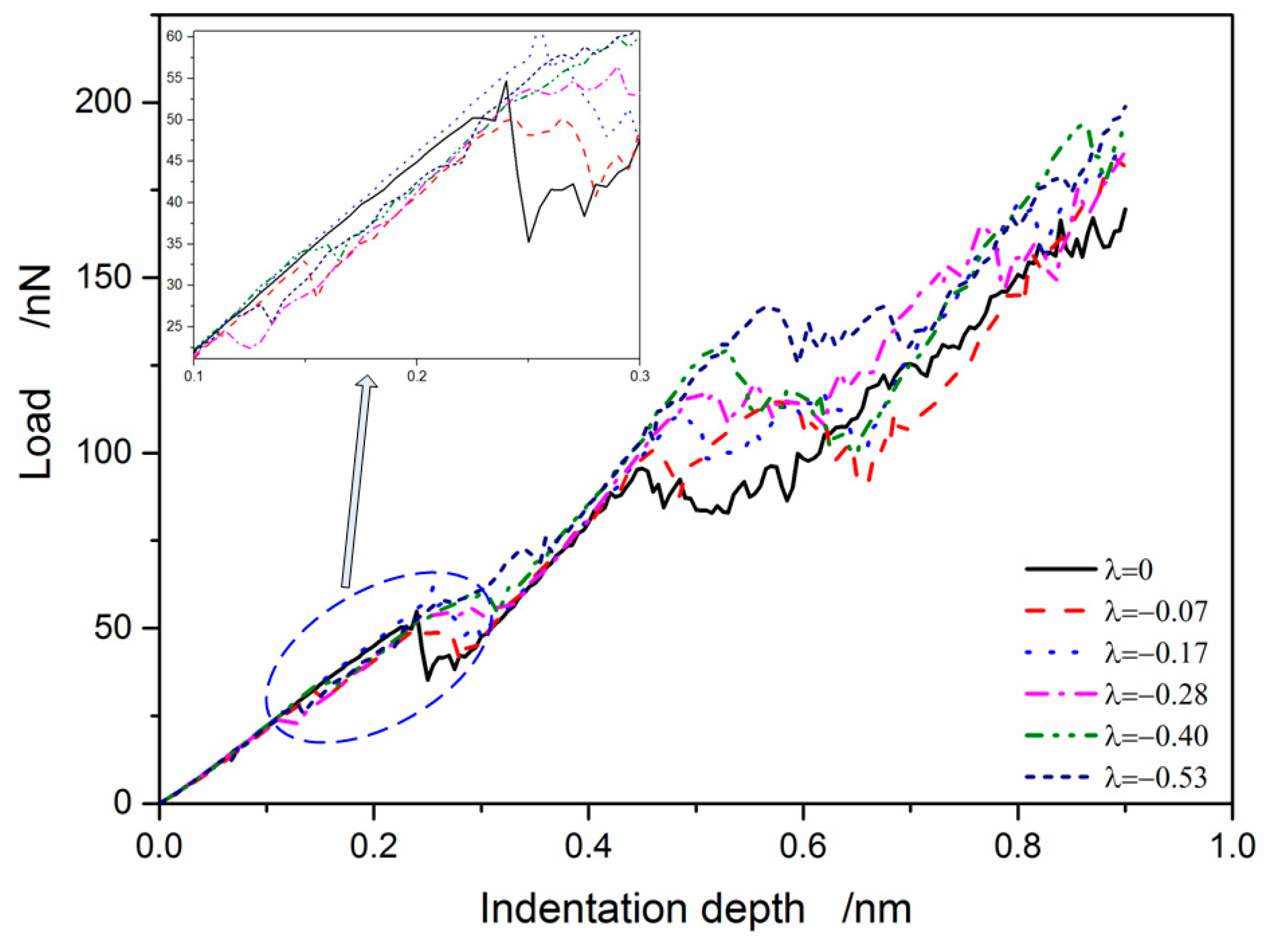
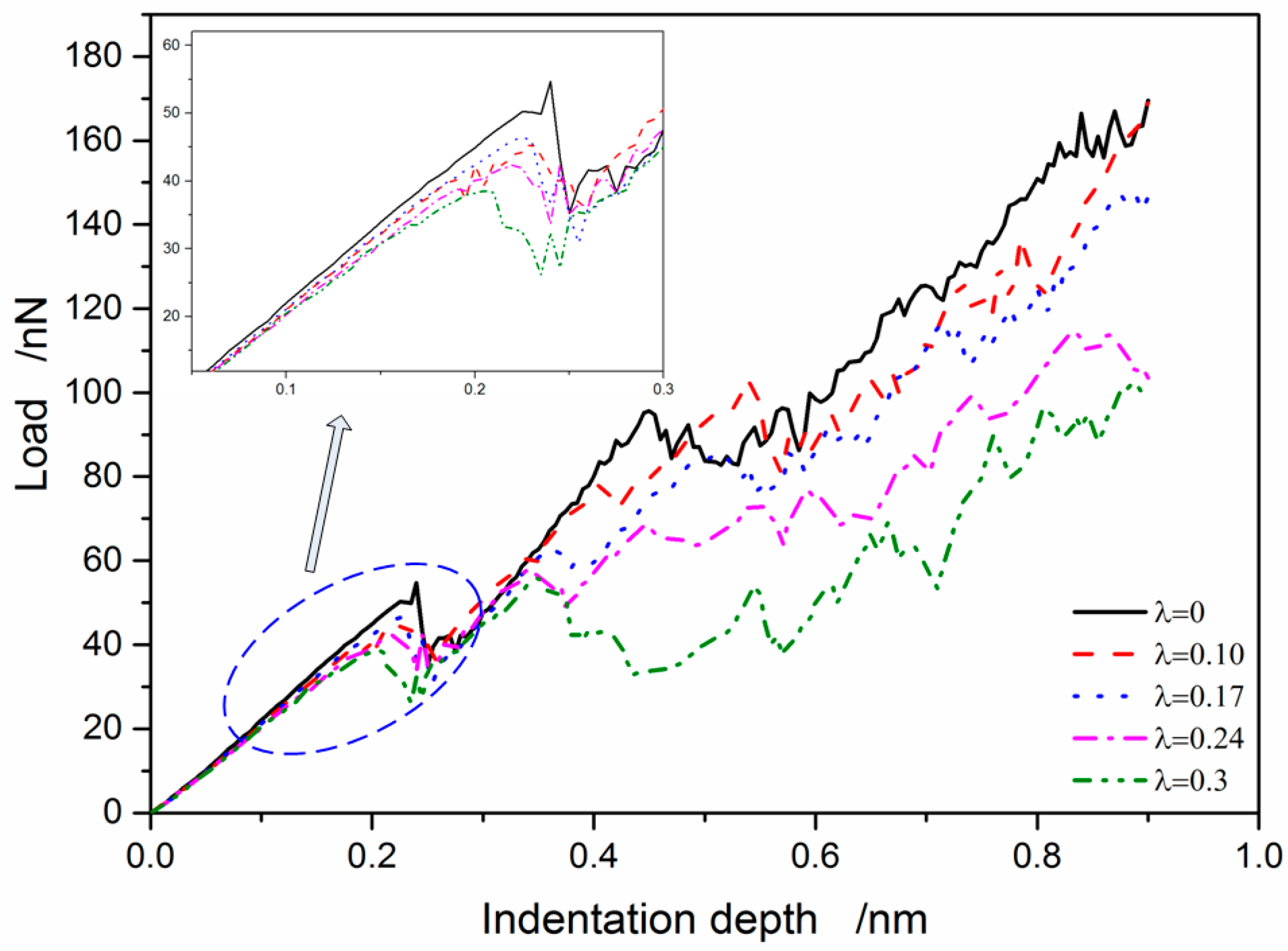

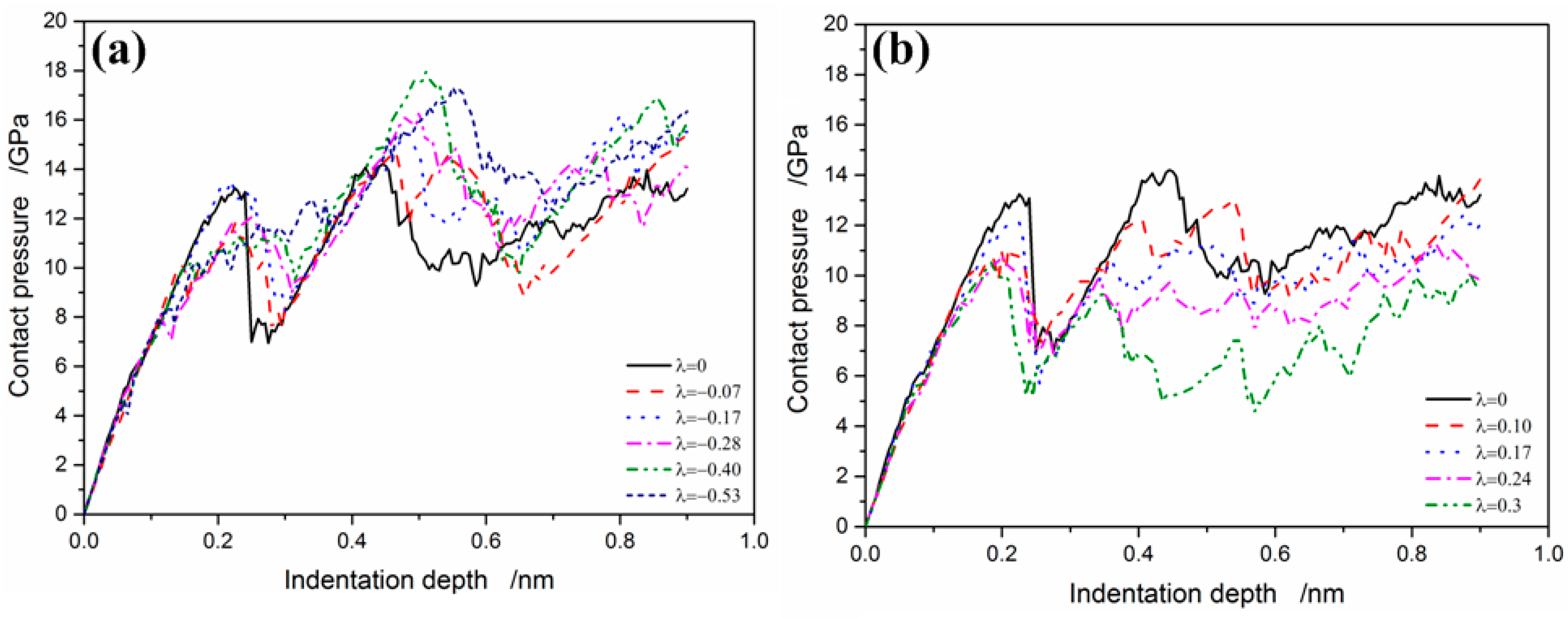
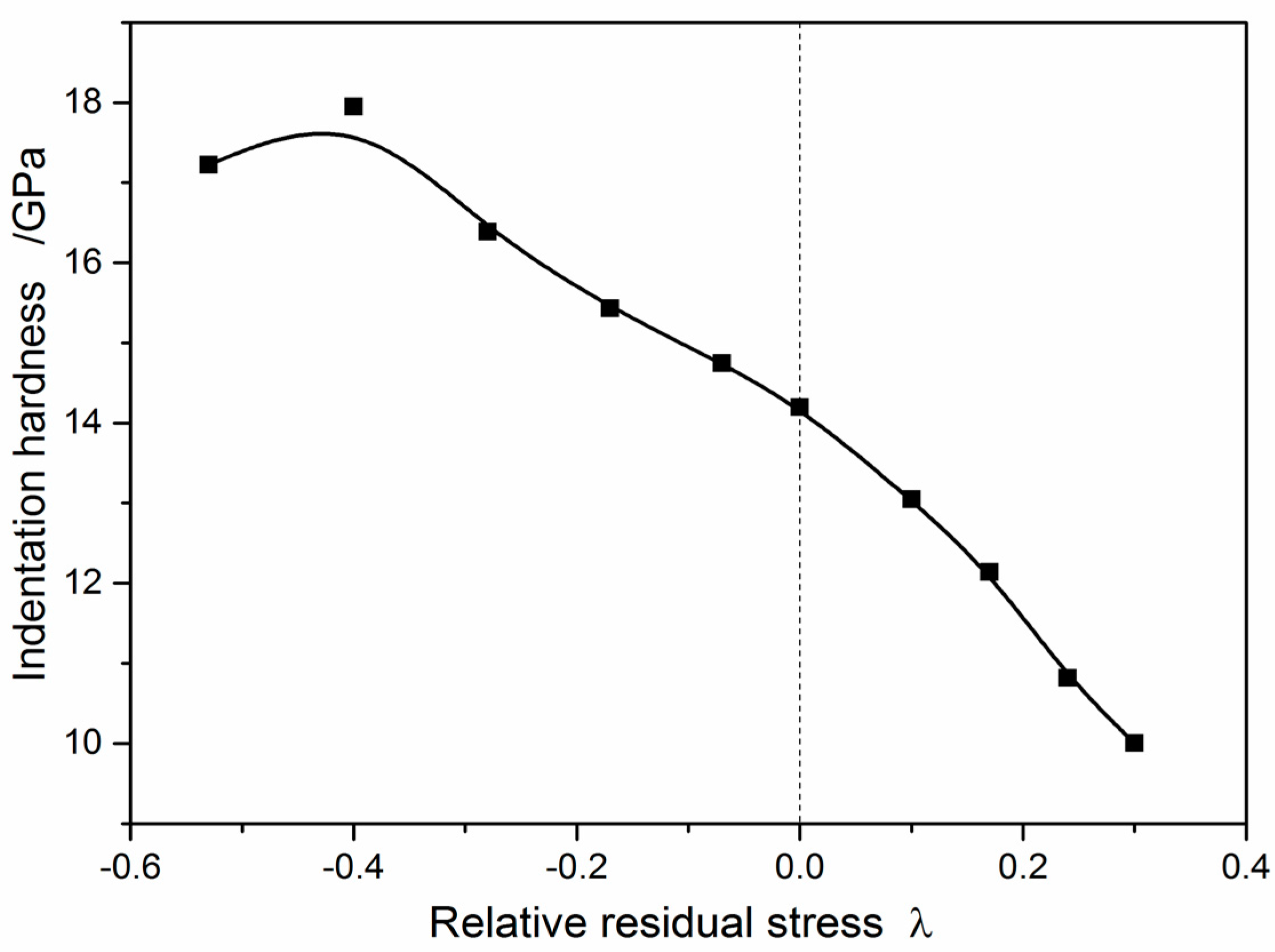


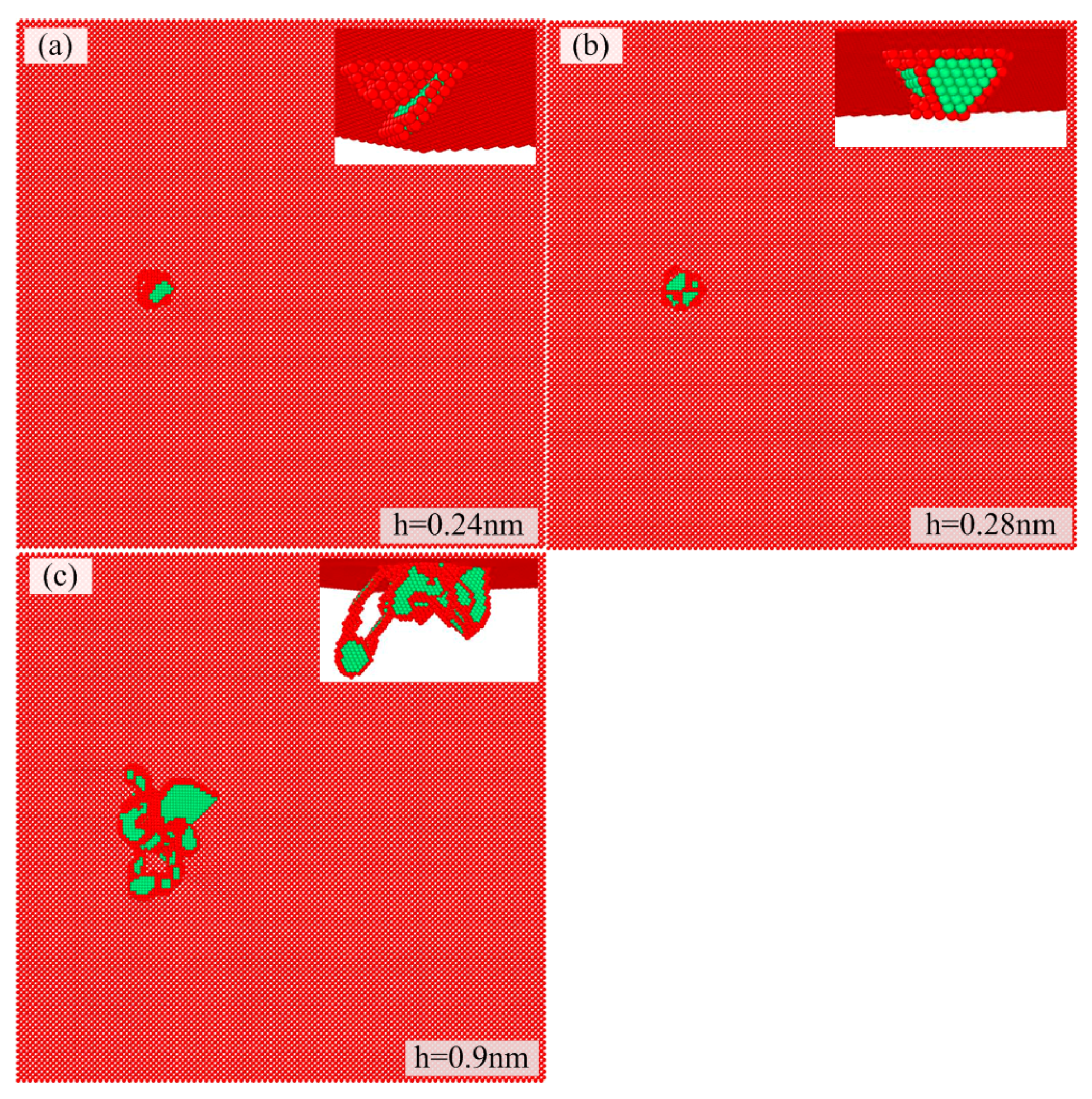
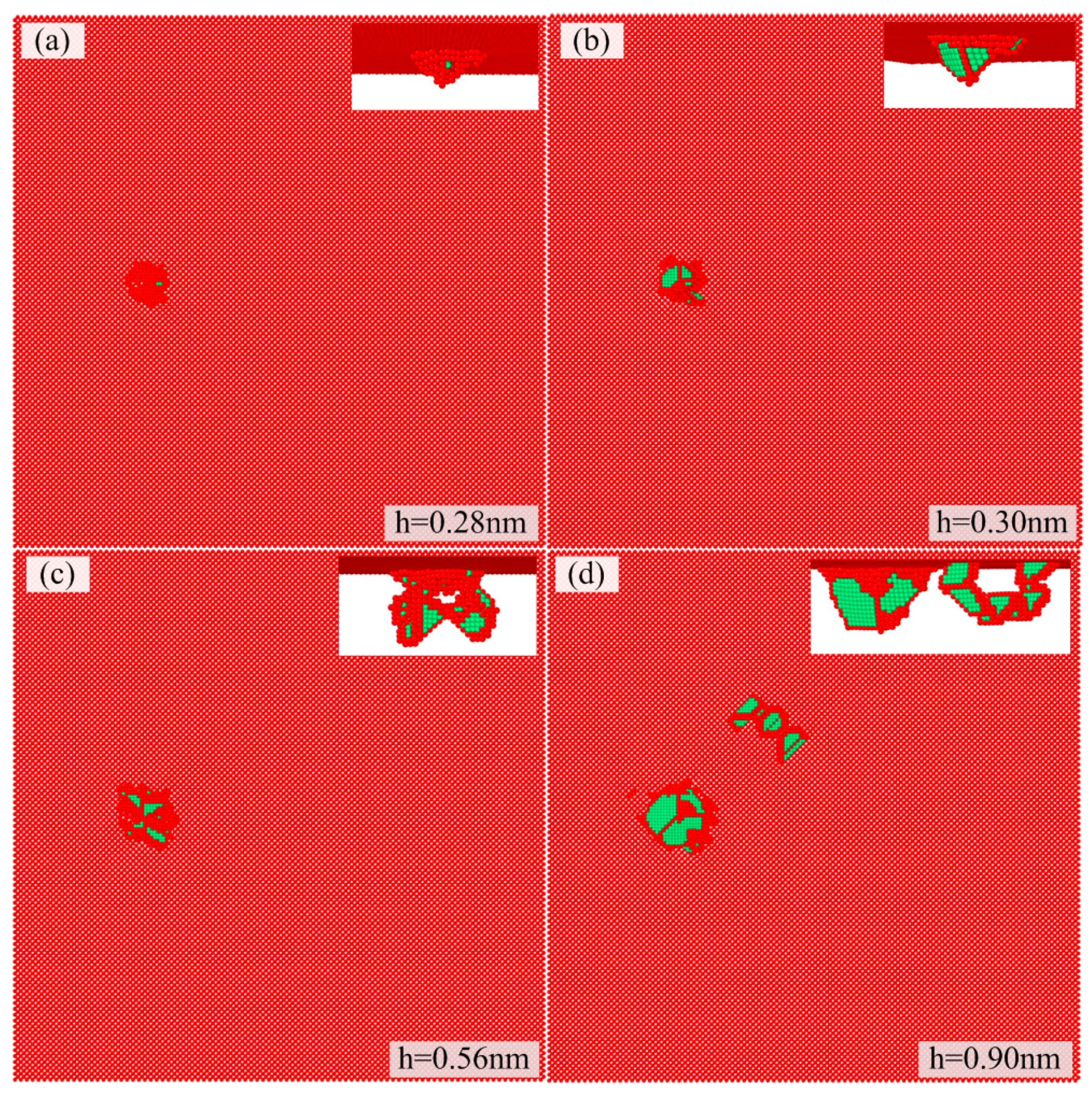


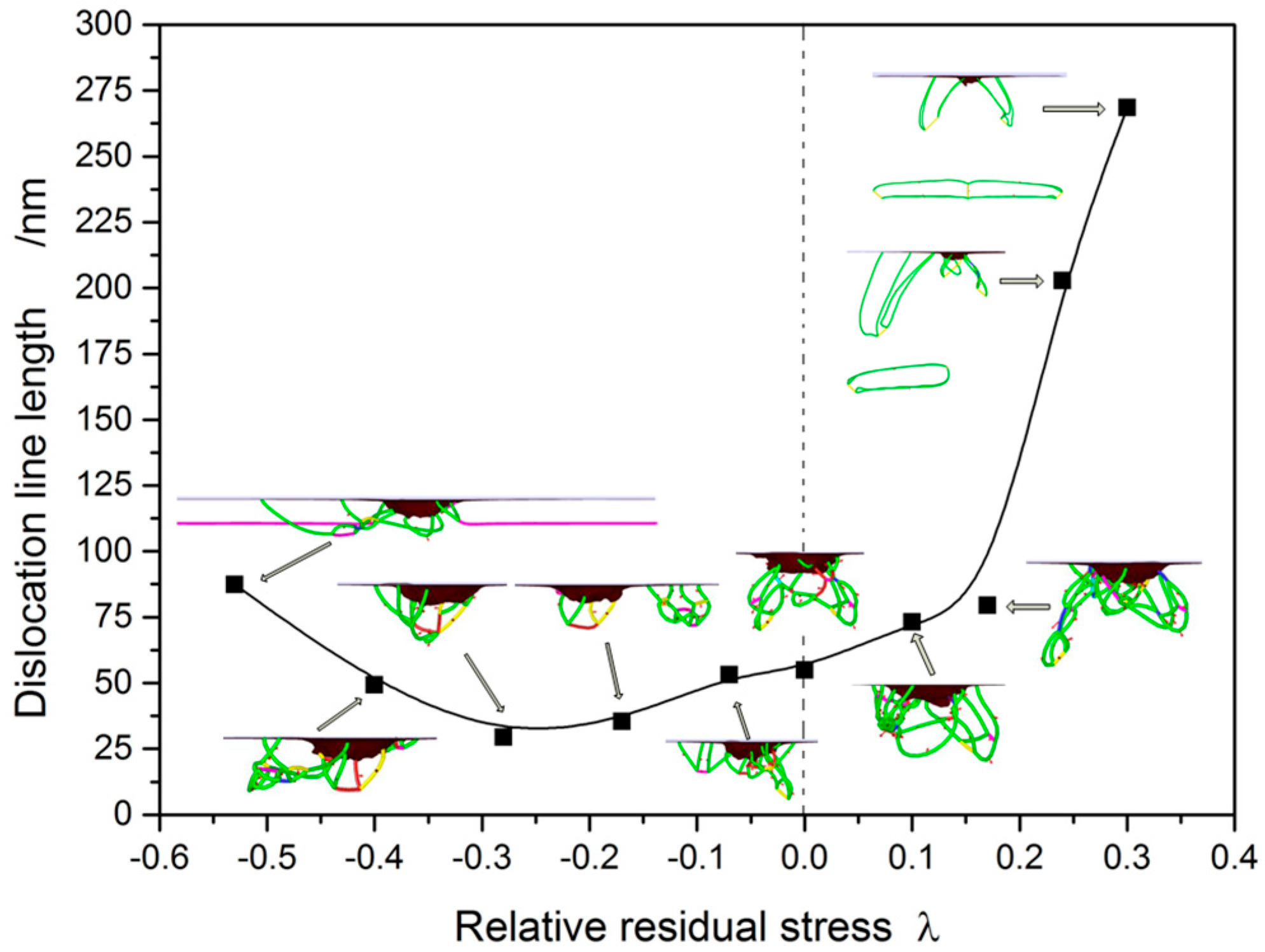
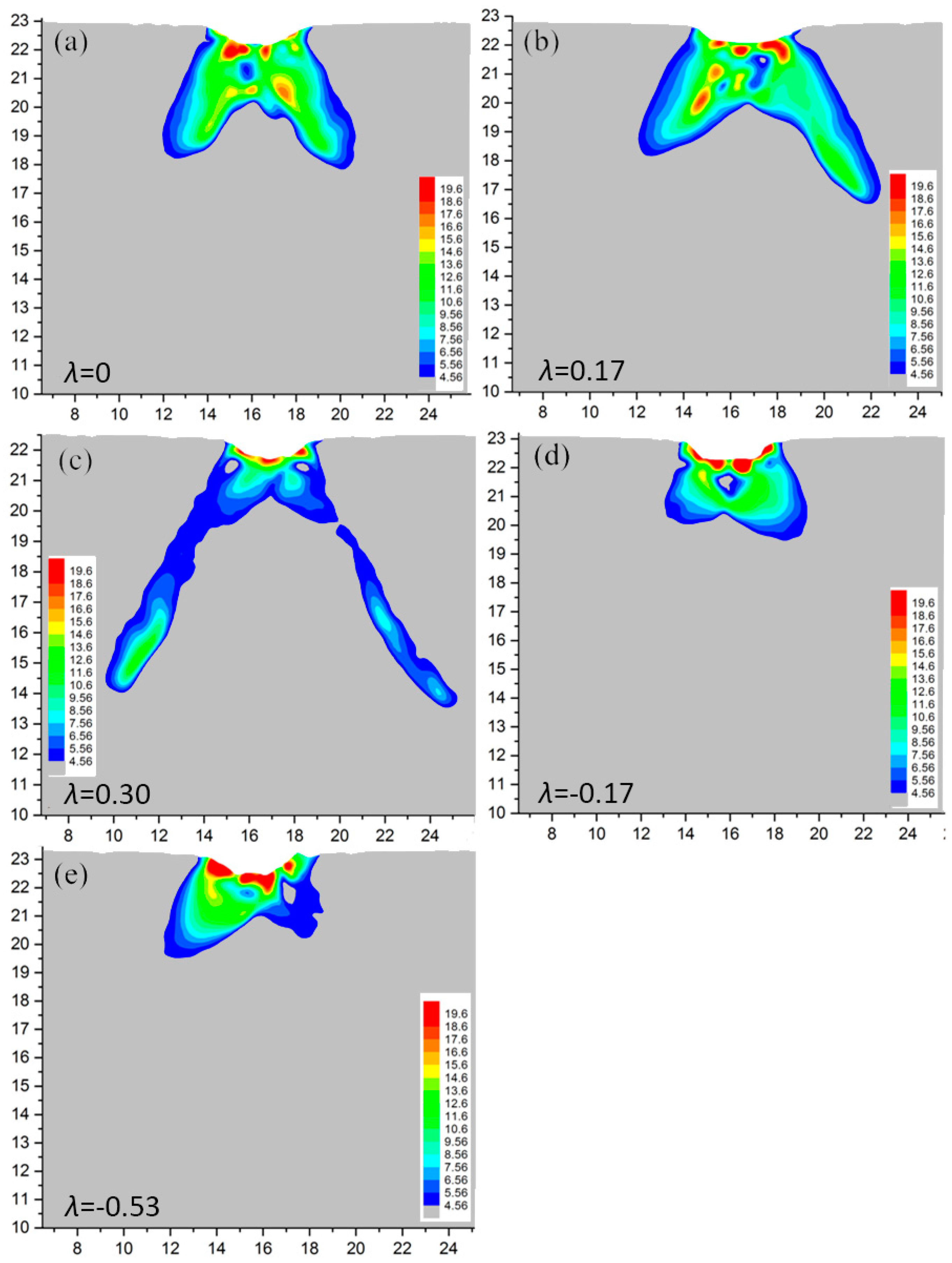
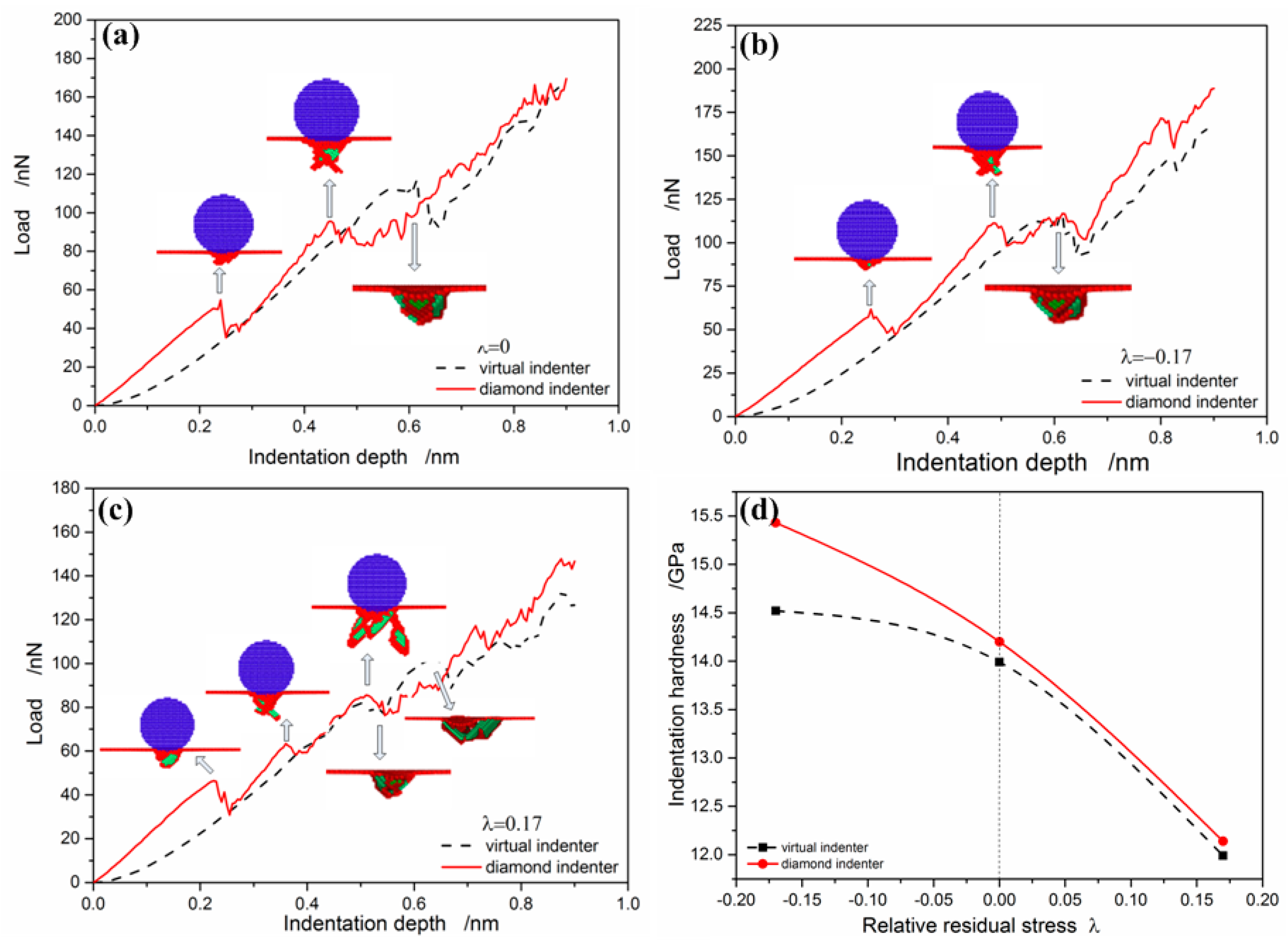
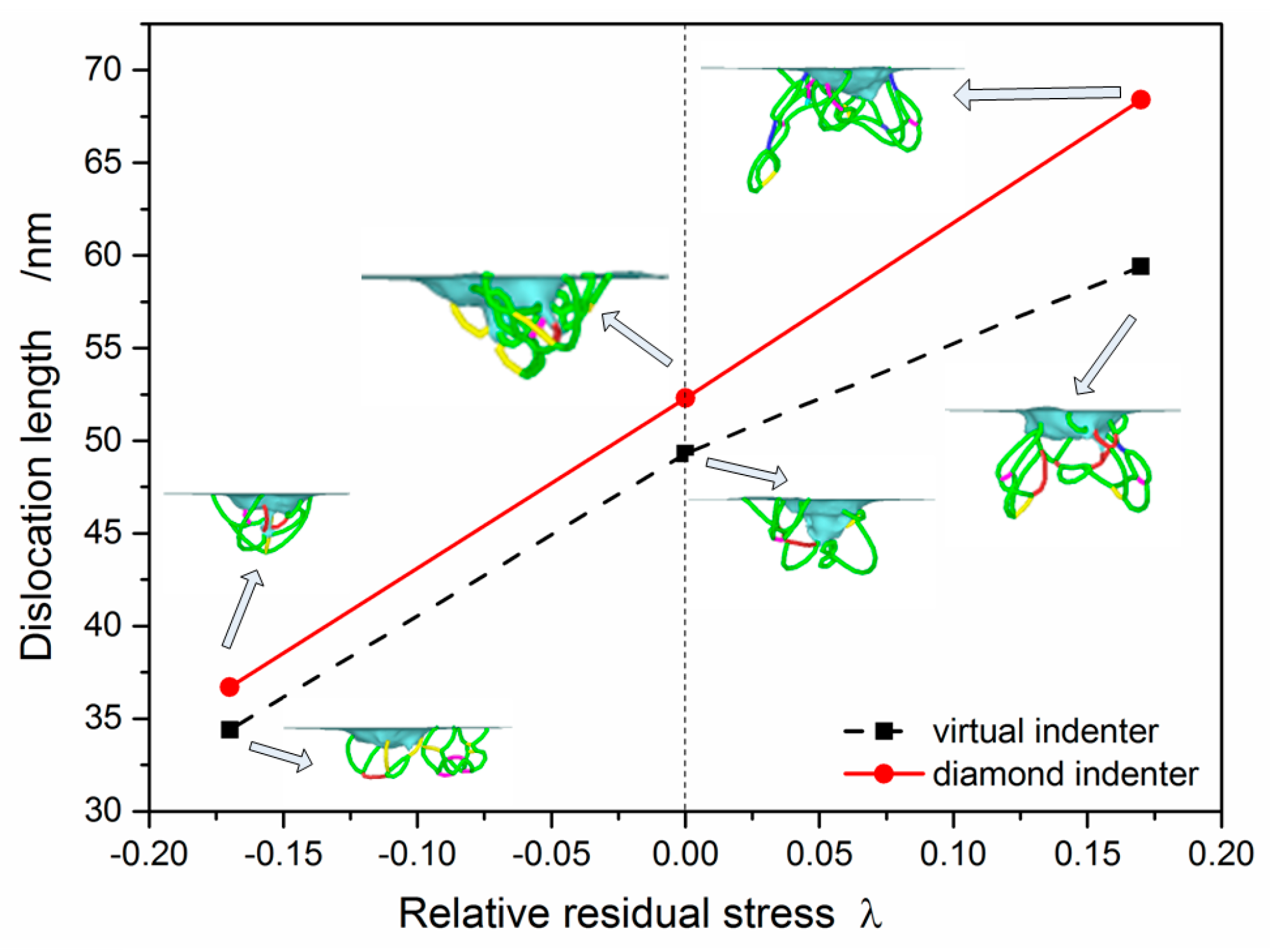
| Pre-strain (%) | −2.5 | −2.0 | −1.5 | −1.0 | −0.5 | 0 | 0.5 | 1.0 | 1.5 | 2.0 |
| σres (GPa) | −2.42 | −1.81 | −1.26 | −0.76 | −0.32 | 0 | 0.46 | 0.79 | 1.10 | 1.36 |
| λ | −0.53 | −0.40 | −0.28 | −0.17 | −0.07 | 0 | 0.10 | 0.17 | 0.24 | 0.30 |
© 2017 by the authors. Licensee MDPI, Basel, Switzerland. This article is an open access article distributed under the terms and conditions of the Creative Commons Attribution (CC BY) license (http://creativecommons.org/licenses/by/4.0/).
Share and Cite
Sun, K.; Shi, J.; Ma, L. Atomistic Insights into the Effects of Residual Stress during Nanoindentation. Crystals 2017, 7, 240. https://doi.org/10.3390/cryst7080240
Sun K, Shi J, Ma L. Atomistic Insights into the Effects of Residual Stress during Nanoindentation. Crystals. 2017; 7(8):240. https://doi.org/10.3390/cryst7080240
Chicago/Turabian StyleSun, Kun, Junqin Shi, and Lifeng Ma. 2017. "Atomistic Insights into the Effects of Residual Stress during Nanoindentation" Crystals 7, no. 8: 240. https://doi.org/10.3390/cryst7080240




